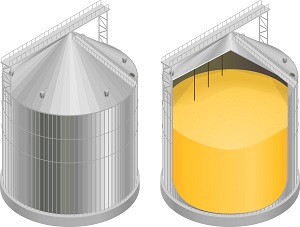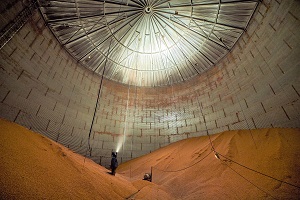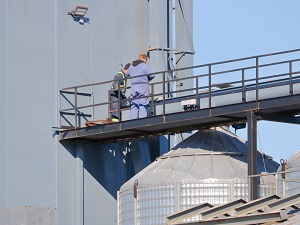Grain handling facilities may receive, handle, store, process, and ship bulk raw agricultural commodities such as (but not limited to) corn, wheat, oats, barley, sunflower seeds, and soybeans.
Types of grain handling facilities include grain elevators, feed mills, flour mills, rice mills, dust pelletizing plants, dry corn mills, facilities with soybean flaking operations, and facilities with dry grinding operations.

Grain Handling Hazards
The grain handling industry is a high hazard industry where workers can be exposed to numerous serious and life-threatening hazards including:
- fires and explosions from grain dust accumulation
- suffocation from engulfment and entrapment in grain bins
- falls from heights
- crushing injuries and amputations from grain handling equipment
- hazardous atmospheres inside storage structures
OSHA Standard 1910.272(e)(1)(ii) [Employees must receive training in] Specific procedures and safety practices applicable to their job tasks including but not limited to, cleaning procedures for grinding equipment, clearing procedures for choked legs, housekeeping procedures, hot work procedures, preventive maintenance procedures and lock-out/tag-out procedures.
Combustible Dust
Grain dust explosions are often severe, involving loss of life and substantial property damage. Grain dust is the main source of fuel for explosions in grain handling because it’s highly combustible and can burn or explode if enough becomes airborne or accumulates on a surface and finds an ignition source.
Both grain dust and ignition sources must be controlled to prevent these often-deadly explosions. Potential ignition sources include hot bearings, overheated motors, misaligned conveyor belts, and welding, cutting, or brazing.
OSHA Standard 1910.272(m)(1)(i) [The employer shall implement preventive maintenance procedures including] Regularly scheduled inspections of at least the mechanical and safety control equipment associated with dryers, grain stream processing equipment, dust collection equipment including filter collectors, and bucket elevators.
Minimize ignition sources by controlling hot work operations.
Preventive maintenance is critical to controlling ignition sources. Plan regularly scheduled inspections for mechanical and safety control equipment including any heat-producing equipment like motors, bearings, and belts.
Follow a housekeeping program that aims to reduce dust accumulations on ledges, equipment, floors, and other exposed surfaces.

Grain Storage Engulfment Danger
Suffocation is a leading cause of death in grain storage bins. Suffocation can occur when a worker becomes buried (engulfed) by grain as they walk on moving grain or attempt to clear grain built up on the inside.
Moving grain acts like "quicksand" and can bury a worker in seconds. "Bridged" grain and vertical piles of stored grain can also collapse unexpectedly if a worker stands on or near it. The behavior and weight of the grain make it extremely difficult for a worker to get out of it without assistance. Grain bins can develop hazardous atmospheres or a lack of oxygen.
Wet weather conditions increase the risk of engulfment for workers inside grain bins. Moisture content causes grain to bridge or clump together. Workers who step onto the bridge to loosen grain from side walls can be buried if the bridge collapses or causes an avalanche under the worker’s weight.
Workers should not enter grain storage bins unless it is absolutely necessary. All workers must be trained for the specific hazardous work operations they are to perform when entering and working inside of grain bins. Workers under 16 years old are prohibited from entering grain bins.

To prevent engulfment and suffocation risks in grain storage bins never walk on the grain to make it flow. Do not enter onto or below bridged grain or when grain is built up on the sides.
OSHA Standard 1910.272(g)(6) Employees shall not enter bins, silos, or tanks underneath a bridging condition, or where a buildup of grain products on the sides could fall and bury them.
Provide workers with body harnesses that have an attached lifeline and other rescue equipment along with the training to ensure the equipment is used properly.
Disconnect, lockout, and tagout machinery, and block-off all powered equipment, especially grain moving equipment (like augers). Grain must never be emptied or moved into or out of the bin while workers are inside because it creates a suction that can pull them into the grain in seconds.
Test the air within a bin or silo prior to entry for the presence of combustible and toxic gases, and to determine if there is sufficient oxygen. If toxicity or oxygen deficiency cannot be eliminated, workers must wear appropriate respirators.
A rescue-trained observer should be stationed outside who is in constant contact (visual, voice, or signal line) with all workers in the bin.

Falls in Grain Storage Facilities
Falls can be a risk as workers move from the vertical exterior ladders on grain bins to the bin roof or through a bin entrance. Falls from height can also occur from many walking/working surfaces located throughout a grain handling facility including floors, machinery, ladders, unguarded holes or catwalks, wall and floor openings, structures, roofs, skylights, platforms, and manlifts.
Workers on any walking/working surface with an unprotected side or edge that is 4 feet or more above a lower level must be protected from falling.
OSHA Standard 1910.212(a)(1) One or more methods of machine guarding shall be provided to protect the operator and other employees in the machine area from hazards such as those created by point of operation, ingoing nip points, rotating parts, flying chips and sparks.
Mechanical equipment within grain storage structures, such as augers and conveyors, present serious entanglement and amputation hazards. Workers can easily get their limbs caught in improperly guarded mechanical moving parts.


.jpg)
